Gallery
- Porcelain bowl: the peaches symbolize longevity and health, the bats add the idea of good luck and happiness.
- Xi Wangmu on a Qing dynasty porcelain plate, beneath a flowering prunus tree
Trees in Chinese mythology and culture tend to range from more-or-less mythological such as the Fusang tree and the Peaches of Immortality cultivated by Xi Wangmu to mythological attributions to such well-known trees, such as the pine, the cypress, the plum and other types of prunus, the jujube, the cassia, and certain as yet unidentified trees. Mythological ideas about trees also extends to various types of fungi which lived or were thought to live underneath certain of these trees, collecting their mysterious essences. [1]
The pine, cypress, and fir are linked by being similar evergreens. Old pine trees are much admired and venerated. [2] Some examples of Chinese cultural symbology can be found in the poetry of Six Dynasties poet Tao Yuanming (365?–427). According to Yeh Chia-ying, one of Tao's most frequently used metaphors is that of the pine tree: symbol of ability to withstand the adversity of cold winds, to withstand the adversity of frosts, nevertheless retaining its own essential character: a situation which can be compared with that of certain persons of metaphorically similar character. [3]
The peach, pear, and plum are linked by being in the genus Prunus. All three of these plants are important in Chinese symbolism. Their symbolism and importance is unknown and therefore unable to be put on this page. [4]
The Fusang tree appears as a more mythological tree, although sometimes claimed to be just like some kind of mulberry. [5]
The 'three friends in winter' is a motif frequently seen in Chinese art. The motif consists of pines, bamboos, and plum trees or else plum trees and a stone. The symbolism is that of longevity, constancy, and flowering during winter, before it is yet spring. In Chinese cultural symbology, this motif is considered suitable to send to those who are poor or lonely. [6] The three friends of winter motif is known as early as the Song dynasty work the Jishanji (霽山集), or, in English, the "Clear Mountain Collection" by Lin Jingxi (林景熙), who lived 1242–1310. [7]
Chinese terms related to trees in Chinese mythology and cultural symbology:
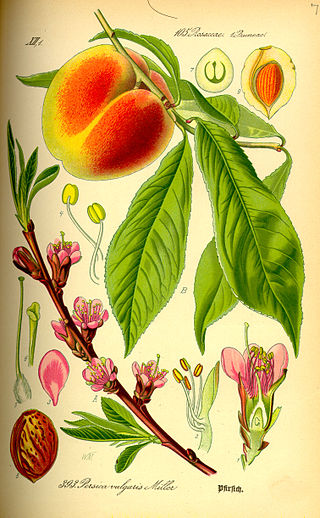
The peach is a deciduous tree first domesticated and cultivated in Zhejiang province of Eastern China. It bears edible juicy fruits with various characteristics, most called peaches and others, nectarines.

Chinese mythology is mythology that has been passed down in oral form or recorded in literature throughout the area now known as Greater China. Chinese mythology encompasses a diverse array of myths derived from regional and cultural traditions. Populated with engaging narratives featuring extraordinary individuals and beings endowed with magical powers, these stories often unfold in fantastical mythological realms or historical epochs. Similar to numerous other mythologies, Chinese mythology has historically been regarded, at least partially, as a factual record of the past.
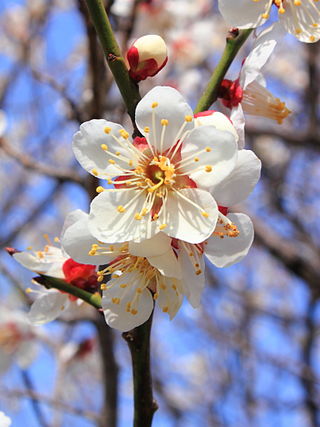
Prunus mume is a Chinese tree species classified in the Armeniaca section of the genus Prunus subgenus Prunus. Its common names include Chinese plum,Japanese plum, and Japanese apricot. The flower, long a beloved subject in the traditional painting and poetry of Sinospheric countries, is usually called plum blossom. This distinct tree species is related to both the plum and apricot trees. Although generally referred to as a plum in English, it is more closely related to the apricot. In East Asian cuisine, the fruit of the tree is used in juices, as a flavouring for alcohol, as a pickle, and in sauces. It is also used in traditional medicine.

Tao Yuanming, also known as Tao Qian, was a Chinese poet and politician who was one of the best-known poets during the Six Dynasties period. He was born during the Eastern Jin dynasty (317–420) and died during the Liu Song (420–479) dynasty. Tao Yuanming spent much of his life in reclusion, living in the countryside, farming, reading, drinking wine, receiving the occasional guest, and writing poems in which he often reflected on the pleasures and difficulties of life, as well as his decision to withdraw from civil service. Tao's simple and direct style was somewhat at odds with the norms for literary writing in his time. In the Tang dynasty (618–907), he was well known as a recluse. During the Northern Song dynasty (960–1127), influential literati figures such as Su Shi (1037–1101) declared him a paragon of authenticity and spontaneity in poetry, predicting that Tao Yuanming would achieve lasting literary fame. However, Tao Yuanming's inclusion in the 6th century literary anthology Wen Xuan argues for at least a beginning of fame in his own era, at least in his own birth area. Tao Yuanming would later be regarded as the foremost representative of what we now know as Fields and Gardens poetry. Tao Yuanming found inspiration in the beauty and serenity of the natural world close at hand. Tao Yuanming is depicted in the Wu Shuang Pu by Jin Guliang.

The three-leggedcrow is a mythological creature in various mythologies and arts of East Asia. It is believed to inhabit and represent the Sun.

Chen Hongshou, formerly romanized as Ch'en Hung-shou, was a Chinese painter of the late Ming dynasty.

In Chinese mythology, Peaches of Immortality are consumed by the immortals due to their mystic virtue of conferring longevity on all who eat them. Peaches symbolizing immortality are a common symbol in Chinese art, appearing in depictions or descriptions in a number of fables, paintings, and other forms of art, often in association with thematically similar iconography, such as certain deities or immortals or other symbols of longevity, such as deer or cranes.
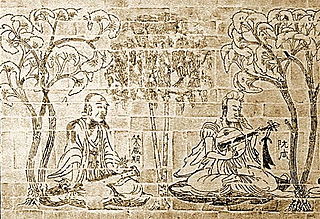
Róng Qǐqī is a mythological Chinese folk hero. He is depicted as a recluse, who shuns material possessions in favour of an ascetic life. Rong was known in Ancient China for a fable involving an alleged encounter with the philosopher Confucius. Although largely forgotten in the following centuries, in his time, the story of his encounter with Confucius was a source of artistic and poetic inspiration. The story is retold in the famous text Liezi, supposedly written by Lie Yukou, a circa 5th-century BCE Hundred Schools of Thought philosopher. Many scholars conclude that Rong Qiqi, while a notable figure in early Chinese literature, is likely fictional or legendary and not historical.

The Three Friends of Winter is an art motif that comprises the pine, bamboo, and plum. The Chinese celebrated the pine, bamboo and plum together, for they observed that unlike many other plants these plants do not wither as the cold days deepen into the winter season. Known by the Chinese as the Three Friends of Winter, they later entered the conventions of Korean, Japanese, and Vietnamese culture. Together they symbolize steadfastness, perseverance, and resilience. They are highly regarded in Confucianism as representing its scholar-gentleman ideal.
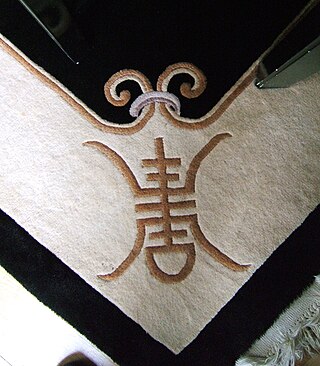
Shòu is the Chinese word/character for "longevity".
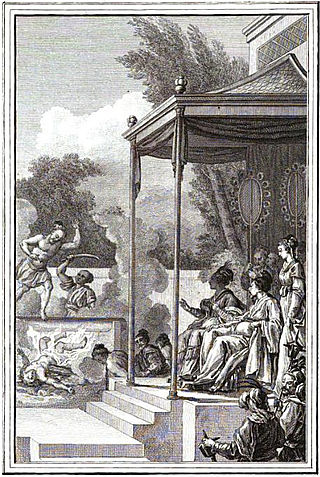
Boyi and Shuqi were two Dongyi brothers from Guzhu, a Dongyi vassal state under the Shang Dynasty. According to tradition, they lived at the time of the transition between the Shang dynasty and the Zhou dynasty. They are remembered in literary culture for their personal and moral virtue, loyalty, and pacifist idealism. Sometimes they are referred to together just as "Boyi", after the elder brother.
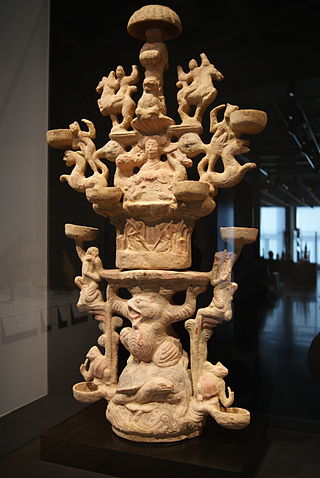
The Kunlun or Kunlun Shan is a mountain or mountain range in Chinese mythology, an important symbol representing the axis mundi and divinity.

Cranes are an important motif in Chinese mythology. There are various myths involving cranes, and in Chinese mythology cranes are generally symbolically connected with the idea of longevity. In China, the crane mythology is associated with the divine bird worship in the animal totemism; cranes have a spiritual meaning where they are a form of divine bird which travels between heaven and man's world. Cranes regularly appear in Chinese arts such as paintings, tapestry, and decorative arts; they are also often depicted carrying the souls of the deceased to heaven. The crane is the second most important bird after the fenghuang, the symbol of the empress, in China.

Prunus subg. Prunus is a subgenus of Prunus. This subgenus includes plums, apricots and bush cherries. Some species conventionally included in Prunus subg. Amygdalus are clustered with plum/apricot species according to molecular phylogenetic studies. Shi et al. (2013) has incorporated subg. Amygdalus into subg. Prunus, thereby including almonds and peaches in this subgenus. The species in this subgenus have solitary flowers or 2–3 in a fascicle.
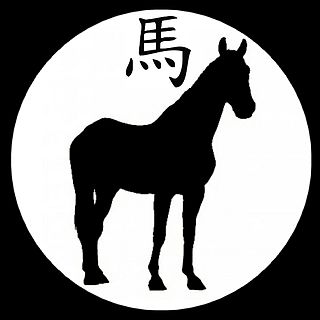
Horses are an important motif in Chinese mythology. There are many myths about horses or horse-like beings, including the pony. Chinese mythology refers to those myths found in the historical geographic area of China. This includes myths in Chinese and other languages, as transmitted by Han Chinese as well as other ethnic groups. There are various motifs of horses in Chinese mythology. In some cases the focus is on a horse or horses as the protagonist of the action, in other cases they appear in a supporting role, sometimes as the locomotive power propelling a chariot and its occupant(s). According to a cyclical Chinese calendar system, the time period of 31 January 2014 - 18 February 2015 falls under the category of the (yang) Wood Horse.

Prunus kansuensis, sometimes called the Chinese bush peach, is a putative species of peach native to China. It is found in Gansu, Guizhou, Hubei, Qinghai, Shaanxi and Sichuan provinces. It is a shrub or tree 3 to 7 m tall, preferring to grow at 1,000 to 2,300 m above sea level. A genetic and morphological study has shown that it is conspecific with Prunus persica, the cultivated peach. P. kansuensis is being investigated as a source for rootstocks and for crop improvement due to its resistance to multiple diseases, to drought, and to frost. It is unaffected by peach mosaic virus, resistant to the root-knot nematode Meloidogyne incognita, and tolerates winter temperatures down to −35 °C (−31 °F).

Legendary weapons, arms, and armor are important motifs in Chinese mythology as well as Chinese legend, cultural symbology, and fiction. Weapons featured in Chinese mythology, legend, cultural symbology, and fiction include Guanyu's pole weapon. This non-factually documented weapon has been known as the Green Dragon Crescent Blade. Other weapons from Chinese mythology, legend, cultural symbology, and fiction include the shield and battleax of the defiant dancer Xingtian, Yi's bow and arrows, given him by Di Jun, and the many weapons and armor of Chiyou, who is associated with the elemental power of metal. Chinese mythology, legend, cultural symbology, and fiction features the use of elemental weapons such as ones evoking the powers of wind and rain to influence battle.
Chinese auspicious ornaments in textile and clothing refers to any form of Chinese auspicious ornaments, which are used to decorate various forms of Chinese textile and clothing, fashion accessories, and footwear in China since the ancient times. Chinese auspicious ornaments form part of Chinese culture and hold symbolic meanings. In ancient China, auspicious ornaments were often either embroidered or woven into textile and clothing. They are also used on religious and ritual clothing and in Xifu, Chinese opera costumes. Auspicious symbols and motifs continue to be used in present-day China in industries, such as home textiles and clothing; they are also used in modern design packaging and interior design. Some of these Chinese auspicious ornaments were also culturally appropriated by European countries during the era of Chinoiserie, where they became decorative patterns on fashionable chinoiserie fashion and textiles.